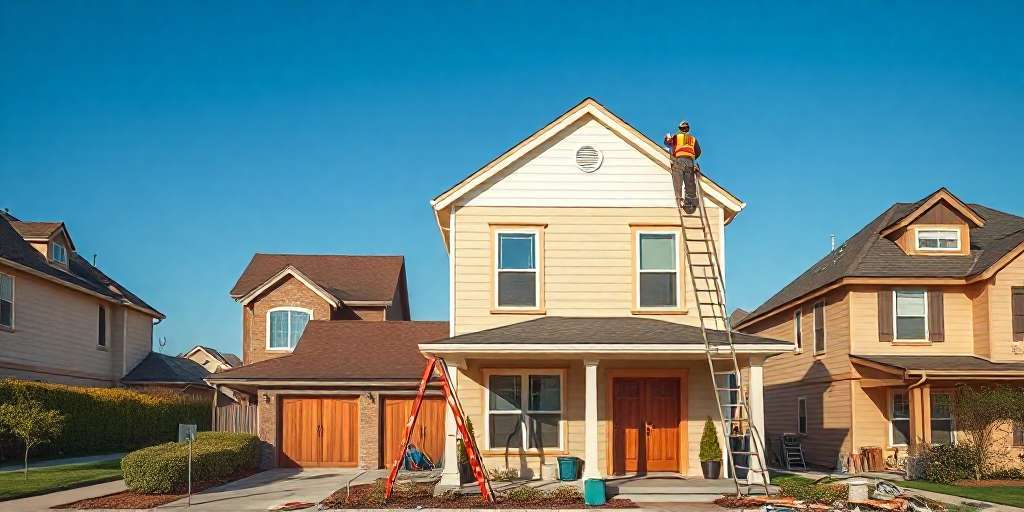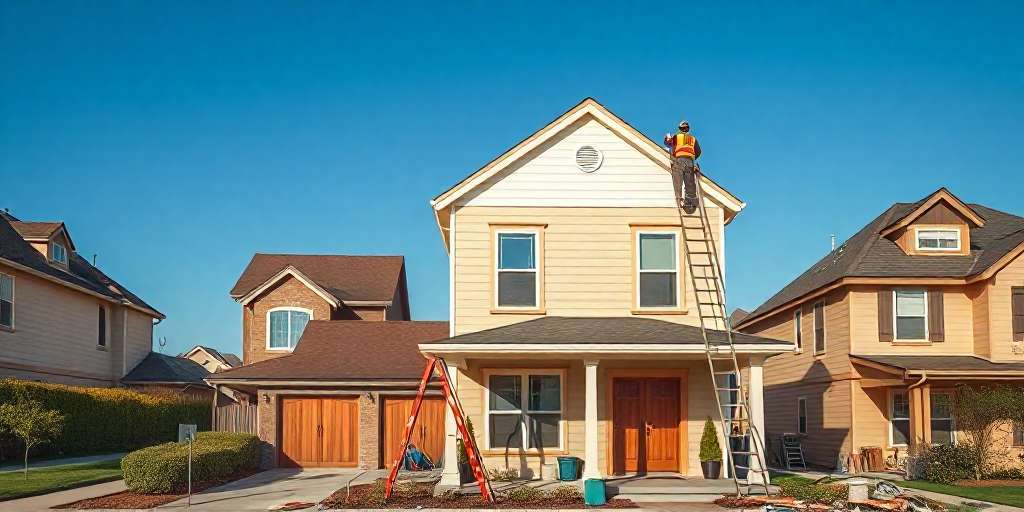
Painting and finishing a house is essential for maintaining its appeal and structural integrity. The process involves several steps that ensure a long-lasting, attractive result. Proper preparation is key to a successful painting project. The right choice of paint and finishes can enhance both interior and exterior spaces. Understanding different materials and techniques is crucial for achieving the desired look and durability. This guide will provide essential insights into each aspect of the painting and finishing process.

Preparing Your Home for Painting
Proper preparation is essential for achieving a successful paint job. Taking the time to assess and prepare the surfaces ensures that the new paint adheres well and provides lasting protection and aesthetic appeal.
Assessing Your Home’s Condition
Begin by evaluating the overall condition of the surfaces to be painted. Look for signs of damage such as:
- Mold
- Rot
- Water damage
Identifying these issues early will help determine necessary repairs before painting starts. Damaged areas may require significant attention to ensure a smooth and durable finish.
Cleaning and Removing Old Paint
Next, thorough cleaning is crucial for effective paint adhesion. Use a hose and brush to wash the surfaces, avoiding power washers in delicate areas. For surfaces with loose or peeling paint, the following steps should be taken:
- Scrape off any flaking paint.
- Smooth rough areas by sanding.
This creates a clean, even canvas for the new coat of paint.
Lead-Based Paint Considerations
For homes built before 1978, checking for lead-based paint is vital. If lead paint is detected, it is essential to hire an EPA-certified professional to handle the removal safely.
Priming and Caulking Techniques
Priming and caulking are key steps that enhance both adhesion and durability of the paint.
Choosing the Right Primer
Select a primer suitable for the type of surface being painted, ensuring it addresses any stains or imperfections effectively. This preparation step is critical for achieving a uniform finish.
Applying Caulk for Water Protection
Caulking should be used to seal gaps between surfaces, such as trim and siding. This prevents water infiltration, which can cause damage over time. A well-executed caulking job minimizes the risk of moisture-related issues.
Choosing the Right Paint and Finishes
Selecting the proper paint and finishes is crucial for achieving a durable and visually appealing result. Understanding the various types of paints and their finishes can greatly impact both the aesthetics and longevity of the paint job.
Understanding Paint Types
Different surfaces and environments require specific paint formulations. Understanding these can guide homeowners in making informed choices.
Best Paint for Exterior Walls
For exterior walls, water-based paints, particularly latex options, are highly recommended. They offer excellent weather resistance and durability against the elements. This type dries quickly and is easy to clean up, making it ideal for outdoor applications.
Interior Paint Options
Interior paints come in various formulations, including low-VOC and no-VOC options. These paints minimize harmful emissions, making them safer for indoor air quality. Specialty paints, such as those formulated for high-moisture areas, can provide added protection in kitchens and bathrooms.
Selecting Paint Finishes
The finish of the paint is also vital as it affects both the visual outcome and the durability of the surfaces.
High Gloss vs. Semi-Gloss Finishes
High gloss finishes are perfect for trim and cabinetry due to their durability and ease of cleaning. However, they tend to highlight imperfections. Semi-gloss finishes offer a balance between sheen and protection, making them suitable for high-moisture areas.
Satin and Eggshell Finishes
Satin finishes provide a soft sheen, ideal for high-traffic areas, as they resist staining while being easy to maintain. Eggshell finishes have a low luster, making them excellent for living rooms and dining rooms, as they hide imperfections while still being durable.
Matte Finishes for Interior Use
Matte finishes are great for areas with minimal traffic. They conceal surface flaws effectively. However, they can be more challenging to clean, making them less suitable for kitchens or bathrooms where moisture is prevalent.
Techniques for Painting Older Homes
Painting older homes requires specific techniques to address their unique features and potential challenges. Employing the right methods ensures a smooth and beautiful finish.
Addressing Imperfections on Surfaces
Older homes often have blemishes such as cracks, dents, or flaking paint. To achieve a flawless look, these imperfections must be properly addressed. Start by thoroughly inspecting the surfaces. Commonly, it involves:
- Filling cracks and holes with appropriate fillers to create a seamless surface.
- Sanding rough areas for better adhesion of the new paint.
- Applying a primer where necessary, especially on raw or repaired surfaces.
Techniques for a Smooth Surface
Creating a smooth painting surface is vital for a professional appearance. The following techniques can enhance the final outcome:
- Use high-quality sandpaper to smooth out surfaces after repairs.
- Consider using a deglosser on surfaces with glossy finishes to ensure the paint adheres well.
- Apply multiple thin coats of paint rather than one thick coat, which helps prevent drips and uneven textures.
When to Remove or Paint Over Old Paint
Deciding whether to remove old paint or simply paint over it can significantly impact the project. Various factors come into play:
- If the existing paint is peeling, cracked, or compromised, it is advisable to remove it completely.
- In cases where the old paint is stable and well-adhered, ensure to clean the surface thoroughly and sand it lightly before applying new paint.
- Testing the paint adhesion can help determine the best course of action; if it sticks well without lifting, painting over may be a suitable choice.
Creative Tips for Selecting Colors
Choosing the right color for a home can transform its look and feel. Below are some creative tips to ensure the selection enhances the character of the residence.
Era-Complementary Color Schemes
When dealing with older homes, it’s essential to respect the architectural style. Opt for colors that complement the era of the house. Classic shades can enhance the home’s detailed aesthetics.
- Muted greens and soft blues work well with Victorian and Craftsman styles.
- Earthy tones such as terracotta can provide warmth to Mediterranean homes.
- Neutral hues like creams or beiges offer a timeless look suitable for various styles.
Testing Paint Samples on Walls
Before committing to a color, testing paint samples on the walls is crucial. This allows homeowners to see how colors look in different lighting.
- Apply samples on large sections of the wall to observe the color at different times of the day.
- Consider the surrounding trim, furniture, and décor to ensure a cohesive look.
Blending Modern and Traditional Colors
Creating a unique palette involves blending traditional colors with modern shades. This technique refreshes the home’s appearance while maintaining its character.
- Incorporate contemporary colors like charcoal grays with classic whites or creams.
- Using bold colors as accents can highlight architectural features without overpowering them.
Hiring Professional Painters
Bringing in professional painters can significantly elevate the quality of a painting project. Their expertise and experience streamline the process, ensuring that every detail is managed effectively.
Why Professional Expertise Matters
Professional painters possess specialized skills that contribute to the success of any painting job. They are knowledgeable about:
- Appropriate materials and finishes to use based on different surfaces.
- Techniques for achieving a flawless application.
- Safety measures, especially in older homes where lead-based paints might be present.
This expertise minimizes mistakes that could lead to costly repairs or repeated work.
Saving Time and Money with Pros
While hiring professional painters may seem like an upfront expense, it can ultimately save money in the long run. Benefits include:
- Efficient project completion within a set timeframe.
- Reduced need for frequent maintenance due to high-quality work.
- Access to bulk purchasing of materials, which often leads to discounts.
By entrusting the job to experts, homeowners can avoid the pitfalls of DIY projects, which often run over budget or exceed the anticipated timeline.
Ensuring Long-Lasting Results
Professional painters not only focus on aesthetics but also on durability. They ensure that:
- The surfaces are properly prepared to enhance paint adherence.
- Quality paints and primers that withstand environmental conditions are used.
- The final application is executed meticulously to prevent issues like peeling or fading.
This commitment to quality results in a beautiful finish that stands the test of time, ultimately contributing to the home’s value and appeal.
Advanced Painting Tips
Mastering advanced painting techniques can significantly enhance the quality and efficiency of a paint job. These tips focus on overcoming challenges and achieving the best finish possible.
Handling Fast-Drying Paint
Working with fast-drying paint can pose challenges during application. To manage this effectively:
- Control the environment by adjusting room temperature and humidity levels.
- Use slow-drying additives that can extend the open time of the paint.
- Work in smaller sections to ensure each area is completed before the paint sets.
Efficient Prep Work Techniques
Preparing surfaces thoroughly is crucial for a successful painting project. Here are some efficient prep work techniques:
- Use reusable fabric drapes instead of single-use plastic sheeting to minimize waste, especially in high-traffic areas.
- Ensure all surfaces are clean and free of debris to promote better adhesion.
- Take time to address existing imperfections to create a flawless base for painting.
Specialty Finishes and Their Uses
Specialty finishes can add unique character to a painted surface. Consider the following:
- Linseed oil paint is favored for its longevity and protective qualities, especially on outdoor surfaces.
- Chalk paint can create a matte, vintage look and is ideal for indoor furniture and decorative items.
- Metallic paints can add shimmer and depth, enhancing features or creating accent walls.
Roller Nap Selection for Various Surfaces
The selection of roller nap length is essential for achieving the desired finish. Longer naps are suitable for:
- Textured surfaces, as they can hold more paint and fill in crevices.
- Applying paint on drywall to ensure an even coat and reduce roller marks.
For smooth surfaces, a shorter nap is preferred to provide a fine finish without excessive texture.
Using quality materials and tools is essential for achieving a flawless paint job. High-grade supplies can significantly impact the durability and appearance of the finished product.
Importance of Quality Materials and Tools
High-Quality Brushes and Rollers
Investing in high-quality brushes and rollers can lead to better application and finish. Premium brushes are made with fine bristles that allow for smooth strokes and reduce the appearance of brush marks. Similarly, high-quality rollers are designed to hold more paint, enabling even coverage and minimizing the number of coats needed.
Avoiding Common Mistakes with Cheap Materials
Cheap materials may save money initially, but they often lead to poor results. Low-quality paints might not adhere well, resulting in peeling or fading over time. Brushes and rollers that shed fibers may leave an uneven texture, requiring additional touch-ups or repainting. Avoiding these pitfalls ensures a more satisfying and lasting paint job.
Pro Tips for the Best Results
- Always choose paint specifically designed for the project at hand, whether interior or exterior.
- Use the right size and type of brush for detailed work and larger areas.
- Consider investing in a paint sprayer for larger surfaces, as it can provide a more uniform finish.
- Store tools properly after use to prolong their lifespan and maintain performance.

